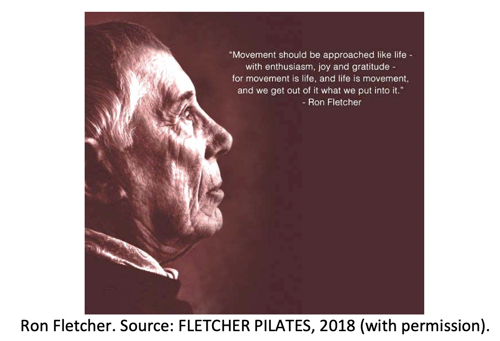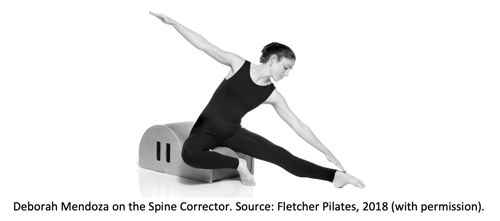Does Pilates breath inspire dance?
Author: Adriano Bittar on behalf of the IADMS Dance Educators’ Committee
Following on from the exciting and intriguing posts from Christine Bergeron (How effective is Pilates as an additional training program for dancers?), and Jennifer Deckert (Breath: A Back-To-School Basic), the focus here is on Pilates and breath, specifically touching upon how they influence the performance of ballet.
The basis for discussion in this post comes from a study that investigated the effects of Fletcher Pilates® in the respiratory systems of young female ballet dancers from a public dance school. This study was presented as a poster at the IADMS 27th Annual Conference in Houston, USA1, and published in Brazil2.
BREATH in SCIENCE and DANCE
It is well reported by exercise physiologists and physiotherapists3,4 that breath plays an important role in providing the body with the necessary energy for daily living. Dancers, such as Duncan, Wigman, Humphrey and Graham also used breath to let the body access its full vibrant potency for artistic expression5. The presence of oxygen enables metabolic reactions and processes to take place, transforming nutrients into chemicals that provide energy in the cells (adenosine triphosphate, ATP) and the release of waste products.
Research tells us that breathing is a frequent movement dysfunction in human beings6,7. The shape of the diaphragm which is the primary muscle in inhalation, affects most body systems, because of its anatomical insertions and connections inside the body. You can find useful descriptions and diagrams of the diaphragm here. Postural modifications can indirectly challenge ventilation (breathing), while coordinated diaphragm contraction may contribute to control of the trunk8,9,10. This is one of the reasons why the placement of the neck, shoulder girdle, ribs and spine can be disrupted by bad breathing. The opposite could also be true: misalignment of the body can cause bad breathing. Therefore, applying good breathing principles to our daily living should turn into a regular practice inside and outside the dance studio.
In training, dancers aren’t often educated on how to optimize breathing and the function of their respiratory systems. Even though ballet dancers frequently take Pilates that teaches breath as a basis for body control, breath is not usually used consciously while they dance1. Often ballet dancers are encouraged to not let the audience see them fatigue, to keep the breath steady and to not belly breathe.
Science is starting to understand the benefits of the use of breath and there are lots of reasons why optimizing breathing might lead to optimized performance when dancing too. Dysfunctional breathing has been linked to health problems such as low back pain, anxiety, panic disorder and mood swings, not to mention decreased pain thresholds and impaired motor control, balance, and movement11, 12. Yoga and martial arts have used different breathing patterns, such as the parceling of air in and out in fractions, or holding the breath, that are practiced to boost better overall health. Western medicine has used breath as well, to improve health and sleep, manage anxiety and control energy levels13. Deep diaphragmatic breathing slows heart rate and blood pressure, especially in times of performance anxiety14. What makes it all even more fascinating is that dancers could use breathing techniques to reprogram their brains, modify breathing behavior, and break inappropriate breathing habits. Research has shown that a better rhythm of breathing could coordinate activity across brain regions associated with smell, memory, and emotions, enhancing their functioning. In dance, this would allow for a greater capacity to learn and perform, as breathing would organize activity of multiple brain regions to help orchestrate complex behaviors15.
What would be the results of training dancers to understand the relevance of correct muscle activation and mechanics of breathing in daily activities and at work? What would it take to teach them to “move from breath”, so to understand the anatomy, physiology, functions and dysfunctions of breathing? Would they be able to add that other layer of perception to dancing? Have a look at Roger Fiametti’s “Respiration Totale” animation here to aid dancers’ understanding. Would it help to recuperate from their fatiguing routines? Would it also be of help to control posture, enhance performance and bring three-dimensional awareness to movement? These seem to be important questions that need explanation.
FLETCHER PILATES®: breath used consciously
Ron Fletcher (1921 - 2011), an American Pilates elder, ex-Graham dancer and choreographer, developed Fletcher Pilates®/FP, the Fletcher FundamentalsTM/FF and the Fletcher Percussive BreathTM/FPB after more than 22 years (1948 - 1970) of non-continuous studies with Joseph and Clara Pilates. Of all the Pilates elders, just Ron taught this breath, as he thought it would better inform his students of the coordination used while breathing. Ron devoted his life to the understanding of human movement, the use of breath, and the coordination and rhythmic motions of the body. You can find out more about Ron Fletcher and the Fletcher Percussive Breath here.
In the FPB, after a deep inhalation, with air being directed to the lateral ribs and to the front and back of the chest, air is blown out through the back of the teeth, providing awareness, resistance and more muscle engagement16. For more information about Fletcher Pilates, click here. Volume and control are key in the FPB, and aspects of breath such as rhythm, regularity, timing and direction are also important. Fletcher believes the breath should be seen happening in the body, as many body parts move when it is done correctly: “Let the breath inspire the movement. Every body can be improved, inside and outside, because the body potential is hardly ever realized. Body Contrology uses the total person. It is movement that demands thought with spirit with breath with body. One supporting the other”17. Body Contrology refers to the name given by Pilates to his method and later on, known by his surname, Pilates.

It has been evidenced by early research in diverse populations 16,18,19,20,21 that FP and the FPB can increase breathing capacity and lung function, maintain abdominal support of the lumbar spine, improve thoracic spinal mobilization and function and restore optimal posture.

Therefore, would Fletcher Percussive BreathTM/FPB, created by Ron Fletcher, from Fletcher Pilates®, prove to be useful to young ballet dancers, in order to allow for better use of their respiratory systems?
AN EVIDENCE-BASED APPROACH TO USING BREATH IN BALLET
An experimental study evaluated 15 female adolescent ballet dancers from a public professional dance school in Brazil. The dancers were injury-free and were already taking ballet classes and/or rehearsing for at least 5 years, for 15 hours per week or more.
They took part in a specific training program with the FP method, that focused on the teaching of the FPB and FF in standing, in 1-hour long classes, for 4 weeks, twice per week whilst continuing their normal dance classes and rehearsals. Dancers were tested before and after the experiment for expansibility of the lower area of the trunk, specifically the thoraco-abdominal region; maximal exhaling time; and muscle strength when breathing in (inspiratory strength).
This study found that the ballet dancers improved their thoracoabdominal expansibility, better coordinating the rhythm of their in and out-breath. The inspiratory strength improved significantly to almost double after the study.
CONCLUSIONS
FP and the FPB had a very positive effect on the breathing patterns of young female ballet dancers, influencing positively the mechanics of the breath and the respiratory muscle strength.
Breathing techniques could play a major role in aiding breathing function amongst young dancers learning ballet. Teachers can incorporate breathing techniques into their classes. Research of different breathing strategies used in the ballet class, before or during performance may highlight other practical aspects concerning the use of the breath in dance and help young dancers to evolve in their art form.
INTERESTED IN LEARNING MORE?
Of all the references given, start off with:
1. Calais-Germain, B. Anatomy of Breath. Seattle, WY: Eastland Press, 2006. An excellent book on the A&P of breath.
2. Roger Fiammetti’s “Respiration Totale” animation, available here. This video will give you an overview of how breath works inside the body.
3. Information on the FPB and FP can be found here.
4. Find out more about Fletcher Pilates at www.fletcherpilates.com.
Adriano Bittar - PT, PhD, State Uni of Goiás, Goiânia, Brazil; Brazil-United Kingdom Dance Medicine & Science Network, adriano@studioabittar.com
References
- BITTAR, A.; MELO, R.; NOLETO, R.; LEMOS, T. The effects of Fletcher Pilates® in the respiratory systems of young female ballet dancers from a public dance school. In: IADMS 27th Annual Conference, 2017, Houston, TX. , p. 78.
- MELO, R.; NOLETO, R.; BITTAR, A.; LEMOS, T. As Influências da Respiração Percussiva Fletcher® nas Mobilidades Torácicas e Abdominal, Força e Coordenação Respiratórias em Bailarinas Jovens de Uma Escola Pública de Dança de Goiânia. MOVIMENTA, V. 11, n. 1, p. 20-34, 2018.
- CALAIS-GERMAIN, B. Anatomy of Breath. Seattle, WY: Eastland Press, 2006.
- HALL, J. Guyton and Hall Textbook of Medical Physiology (13th edition). Philadelphia, PA: Elsevier, 2016.
- SUQUET, Annie. O Corpo Dançante: um laboratório de percepção. In: COURTINE, Jean-Jacques; CORBIN, Alain; VIGARELLO, Georges. História do Corpo: 3. As mutações do olhar: O século XX. Petrópolis: Vozes, 2008.
- BORDONI, B.; ZANIER, E. Anatomic connections of the diaphragm: influence of respiration on the body system. Journal of Multidisciplinary Healthcare. 2013; 6: 281-291.
- BORDONI, B.; PURGOL, S.; BIZZARRI, A.; MODICA, M.; MORABITO, B. The Influence of Breathing on the Central Nervous System. Cureus. 2018; 10(6): e2724.
- HODGES, P.; RICHARDSON, C. Relationship between limb movement speed and associated contraction of the trunk muscles. Ergonomics, v. 40, p. 220-1230, 1997.
- HODGES, P.; GANDEIVA, S. Activation of the human diaphragm during a repetitive postural task. J Physiol Lond, v. 522, p. 165-175, 2000.
- HODGES P.; GANDEIVA S. Changes in intra-abdominal pressure during postural and respiratory activation of the human diaphragm. J Appl Physiol, v. 89, p. 967-976, 2000a.
- KIESEL, K.; RHODES, T.; MUELLER, J.; WANINGER, A.; BUTLER, R. Development of a Screening Protocol to Identify Individuals with Dysfunctional Breathing. Int J Sports Phys Ther. 2017 Oct; 12(5): p. 774–786.
- KUVAČIĆ, G.; FRATINI, P.; PADULO, J.; ANTONIO, D.; DE GIORGIO, A. Effectiveness of yoga and educational intervention on disability, anxiety, depression, and pain in people with CLBP: a randomized controlled trial. Complementary therapies in clinical practice, 31, 262-267, 2018.
- MCLAUGHLIN, L.; GOLDSMITH, C.; COLEMAN, K. Breathing evaluation and retraining as an adjunct to manual therapy. Man Ther. 2011; 16(1): p. 51-52.
- RAYMOND, J.; SAJID, I.; PARKINSON, L.; GRUZELIER, J. Biofeedback and dance performance: a preliminary investigation. Applied Psychophysiology and Biofeedback, v. 30, n. 1, p. 65-73, 2005.
- ZELANO, C.; JIANG, H. ZHOU, G.; ARORA, N.; SCHUELE, S.; ROSENOW, J.; GOTTFRIED, J. Nasal Respiration Entrains Human Limbic Oscillations and Modulates Cognitive Function. Journal of Neuroscience. 36 (49) 12448-12467, 2016.
- BITTAR, A.; JUBÉ, L.; HANCOCK, C.; PAIVA, T.; SABIN, K. The effects of Fletcher Towelwork® in women with breast cancer: clinical trial. PMA Conference, Phoenix, 2016.
- FLETCHER PILATES, 2018. Retrieved from .
- VOLÚ, A.; NORA, F.; BITTAR, A. The Importance of Fletcher Towelwork® in Decreasing Shoulder Pain of a Paraplegic bound to a Wheelchair: case study. MOVIMENTA. vol. 7, n. 3, 2014.
- SILVA, G.; RIBEIRO, C.; BITTAR, A. Efeitos do método Fletcher Matwork® na expansibilidade torácica. Artigo de esp. - PUCGO, GYN; 2014.
- SILVA, G.; RIBEIRO, C.; BITTAR, A. The Sub-acute Effects of the Fletcher Pilates® Mat on a Group of PE from Athletics Fitness Center. Post-graduation in Pilates, monograph, PUC/GO, 2014a.
- SILVA, M.; DIAS, K.; BITTAR, A. The Effects of Fletcher Towelwork® in the Peripheral Muscle Strength and Thoracic Extension of Dentists. Summary II International Fletcher Pilates® Conference. Tucson/USA, 2015.